Gaseous nitrogen is used in a variety of systems and processes in the food manufacturing and packaging industries. Often regarded as the industry standard for non-chemical preservation, nitrogen is an inexpensive, readily available option. Suited for a variety of uses, Nitrogen needs to be monitored for purity and potential contaminants. Depending on the type of use, the distribution channel, and the required purity levels, different testing plans should be implemented to ensure safety.
Uses For Nitrogen In Food Process
Because foods are comprised of reactive chemicals, it is the job of packaging specialists and food manufacturers to find ways to protect nutrients and ensure the quality of their product. Oxygen can be harmful to packaged foods as this gas causes the food to oxidize and can encourage the growth of microorganisms (Welt and Connaughton, 2017). Foods that are particularly susceptible to these risks include fatty meats, fish, veggies and ready-to-eat products. In fact, a third of fresh food does not reach consumers due to transport spoilage (Sengupta, 2017). Modifying the atmosphere of the packaging can be an effective way to ensure that products remain safe for consumers.
 |
To increase the shelf life of fresh products, many manufacturers choose to modify the atmosphere of the packaging to include higher levels of nitrogen (American Chemistry, 2010). Because it is a safe, inert gas, nitrogen is an excellent replacement for oxygen or supplemental gas in food packaging and manufacturing. Increased nitrogen preserves freshness, protects the nutrients, and prevents aerobic microbial growth.
The main challenge with modifying the atmosphere of packaging is that some food products do require a small amount of oxygen to maintain their coloring and texture (Welt and Connaughton, 2017). Red meats, for example, will turn an unappetizing color when deprived of oxygen. Food manufacturers sometimes choose a lower nitrogen purity to make their product more palatable to consumers.
In addition to meats and vegetables, nitrogen is used with increasing frequency in the coffee and beer industries. Guinness, for example, is known for its signature foam produced by nitrogen gas (Welt and Connaughton, 2017). Additionally, coffee brewed with nitrogen has become quite popular. Beverage manufacturers who introduce nitrogen into their product must meet certain purity levels and ensure that the gas is free from contamination.

The Importance Of Pure Gas Testing
Because Nitrogen is a critical component in the preservation, transportation, and quality control of fresh food products and beverages, it must be tested regularly. It is susceptible to decreases in purity levels and contaminants like gas, particles, water, oil, and microorganisms. Individual systems call for different testing protocols. Variables to take into consideration include nitrogen cylinders verses nitrogen generators, system age and build, distribution piping and the type of contact the gas has with the product. Complete a risk assessment to ensure an in-depth understanding of your system and its unique needs.
Nitrogen Cylinders and Generators
Food manufacturers and packaging plants that choose to work with nitrogen cylinders or generators can expect to have clean and dry nitrogen at the source. However, according to Nikki Smith, Quality Manager at Trace Analytics, LLC, it is important to account for the distribution line. Smith explains that testing for gas purity at the point of use is a reliable way to ensure that the piping is not contaminating the pure gas.
Unhealthy systems with ineffective filters or leaks can reduce the purity of gas and introduce contaminants like volatile hydrocarbons, water, oil, or particles. Leaks can lead to lower purity levels or contamination because they create a vacuum which brings in atmospheric air containing oxygen, moisture, and hydrocarbons (Kandl, 2005). Ineffective filters or materials can introduce particulate contamination. Whether your system works with cylinders or a generator, testing at multiple points ensures that the quality of gas does not deteriorate down the line. A third-party, accredited laboratory can provide thorough analysis for pure gas systems to ensure that the gas at the end of the distribution line is as pure as when it flowed directly out of the cylinder or generator.
Anaerobes
 |
Using nitrogen to modify the atmosphere of packaged foods does prevent against aerobic bacteria growth, but does not stop the growth of anaerobes. Anaerobes are microorganisms that can grow without oxygen. These microorganisms can be particularly dangerous and need to be carefully guarded against as they lead to recalls and consumer illnesses.
Because anaerobes do not need oxygen to grow, poorly maintained Nitrogen systems can be at risk for this type of contamination. Obligate anaerobes only grow with a complete lack of oxygen, while Facultative anaerobes can use oxygen but do not require it to grow (USDA, 2012). Facultative bacteria include Listeria, E. coli and Botulism.
This year alone, over 20 food manufacturers issued recalls due to Listeria (FDA, 2018). Recalls can be costly at best, and devastating at worst, causing entire shut downs. Since Listeria can survive in the atmosphere, it can pass through the system and impact food if proper precautions are not administered. Other dangerous anaerobes to test for include E. coli, C. botulinum, and C perfringens (USDA. 2012).
How Pure Gas Testing Works
Trace Analytics, LLC, uses a Gas Chromatograph-Mass Spectrometer-Flame Ionization Detector (GC-MS-FID) to test for gas purity and gas contamination. The three different pieces of equipment function together to provide precise and thorough results. The Flame Ionization Detector recognizes gas contaminants like TVHC, CO, CH4 and CO2, while the Mass Spectrometer detects ions by mass and can separate out Oxygen, Nitrogen, Argon, and water.
To determine purity, the gas sample is compared to controls using NIST traceable gas standards. Smith explains that manufacturers base their purity goals on their usage. For example, some manufacturers might require 99.0% nitrogen purity, while others could allow for a lower purity.
 |
Optical microscopy is used to test for particulate contamination. This determines particle size and count. This method allows for the evaluation of point-of-use filtration and can identify problems due to add-ons after the filter that create contamination like rust, metal shavings, o-ring materials, solder, and Teflon tape.
To properly test for anaerobic contamination, users take samples using the Pinocchio Super II Impaction Sampler along with blood agar contact plate media. A GasPak is opened in a sterile bag which removes the oxygen from the bag and ensures only anaerobic microbes can grow. An accredited microbiology lab can then incubate the media and use Gram Staining to determine whether the gas is contaminated. If a company suspects Listeria or E. coli contamination, specialty plates can be used which will reveal a positive or negative result.
Requirements And Regulations
The release of SQF Code Edition 8 has brought some clarity to the testing process and further protects end-users from contaminated products. This new edition states that compressed air and other gases must be clean and regularly monitored.
“11.5.5.1 Compressed air or other gases (e.g. nitrogen, carbon dioxide) that contacts food or food contact surfaces shall be clean and present no risk to food safety.”
“11.5.5.2 Compressed air systems, and systems used to store or dispense other gases used in the manufacturing process that come into contact with food or food contact surfaces shall be maintained and regularly monitored for quality and applicable food safety hazards.”
With the addition of the words “or other gases”, nitrogen, mixed gases and pure gases are now included and must be monitored regularly. Individual manufacturers should assess their risks and work with an ISO 17025 accredited laboratory to determine the appropriate tests. Trace Analytics, LLC offers testing for pure gas, particles, water, oil, and microorganisms.
Conclusion
Nitrogen has critical application in the food manufacturing and packaging industries. Its quality and purity have direct impact on both food and beverage products. Because of this, it is important to test for purity and contaminants regularly with a third-party, accredited laboratory. Perform a risk assessment to gain a thorough understanding of your system and risks. Then implement a monitoring plan with regular testing for your nitrogen system to ensure the safety of your end-product. Contact us to receive a personalized Pure Gas testing quote.
For more information on pure gas testing, contact Trace Analytics, LLC at sales@airchecklab.com or visit: https://learn.airchecklab.com/pure-gas.
To read similar Food Industry articles visit www.airbestpractices.com/industries/food.
Resources:
FDA. “2018 Recalls, Market Withdrawals & Safety Alerts.” U S Food and Drug Administration Home Page, Center for Drug Evaluation and Research, 2018, www.fda.gov/Safety/Recalls/ArchiveRecalls/2018/default.htm.
Food Safety Inspection Service. “Introduction to the Microbiology of Food Processing.” United States Department of Agriculture, Aug. 2012.
Kandl, Frank. “Ten Steps to Maintaining Gas Stream Purity.” American Laboratory, 2005, www.americanlaboratory.com/914-Application-Notes/19168-Ten-Steps-to-Maintaining-Gas-Stream-Purity/.
“Nitrogen Generators for Food Processing.” South-Tek Systems, 2018, www.southteksystems.com/foods/.
“Nitrogen Use in Food Processing and Packaging.” Compressed Air Best Practices Webinar, presentation by Bruce Welt, and David Connaughton, Air Best Practices, 14 Sept. 2017. https://www.airbestpractices.com/system-assessments/air-treatmentn2/nit…
“Pure Gases.” Compressed Air Testing - Trace Analytics, Trace Analytics, LLC, 2018, www.airchecklab.com/services/pure-gases/.
Sengupta, Somini. “How Much Food Do We Waste? Probably More Than You Think.” The New York Times, The New York Times, 12 Dec. 2017, www.nytimes.com/2017/12/12/climate/food-waste-emissions.html.
Smith, Nikki. “How Trace Analytics Tests Pure Gas.” 19 Sept. 2018.
“The Benefits of Nitrogen for Food Processing.” American Chemistry Magazine, 2010.




